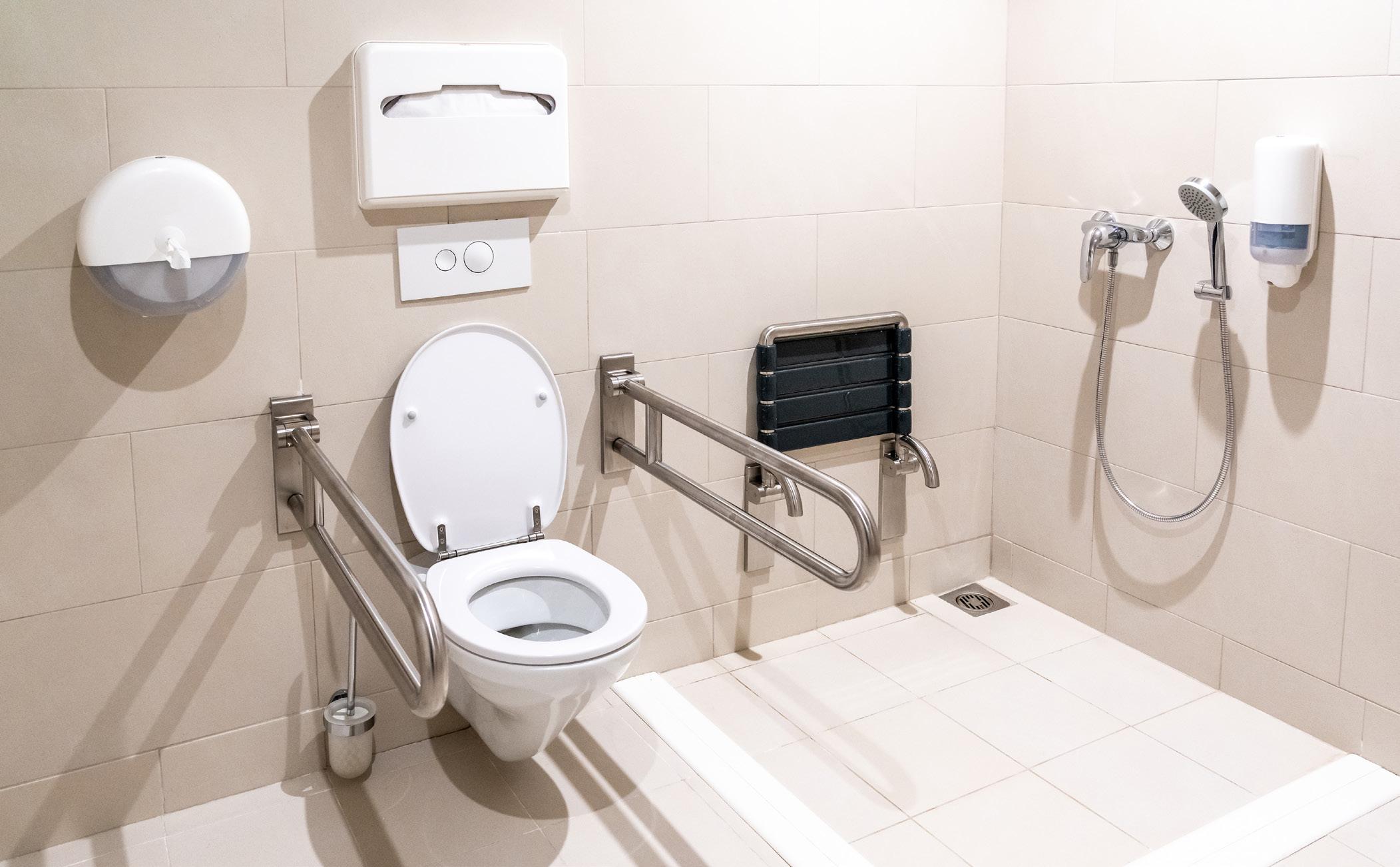
16 minute read
Changing Places
Changing Places to provide accessible facilities
With Round 2 of the Changing Places Fund recently opening to expressions of interest, Government Business looks at the programme and what has already been achieved
Thousands of people in the UK are unable to go out to meet friends, or go to the shop or a restaurant due to a lack of adequate facilities. People living with learning disabilities, motor neurone disease, multiple sclerosis, cerebral palsy and other conditions often do not have access to suitable toilet and changing facilities.
In 2020, the government made it compulsory to include a Changing Places toilet in certain new, publicly accessible buildings. The Changing Places Fund was launched in summer 2021 to help local authorities increase the number of Changing Places toilets. Round 1 of the Changing Places Fund allocated £23.5 million to 191 local authorities across England, to fund 500 Changing Places toilet facilities. Round 2 of the fund has recently opened.
Who are they for?
Changing Places toilets were created to meet the needs of those with disabilities and complex care needs. They were created for those who need carer support, appropriate equipment and more space.
Changing Places offer more than standard accessible toilets, providing more space and necessary equipment. Standard disabled toilets are designed to meet the needs of disabled people who can use a toilet independently and cannot accommodate large wheelchairs and carers. It is estimated that more than 250,000 people need these facilities to be able to get out and about. Changing Places toilets are larger than standard accessible toilets and provide equipment such as hoists, privacy screens, adult-sized changing benches and peninsular toilets, as well as space for carers.
Changing Places facilities are intended for people with complex disabilities who require hoisting from their wheelchair onto the toilet and providing support once on the toilet and those who are incontinent and who require hoisting from their wheelchair onto a height adjustable adult sized changing bench to have their continence pads changed. They are also designed for those who are not wheelchair users but whose other complex needs are not met in current public toilet provision including disabled children and adults who have balance or health/ size issues, or severe autism or challenging behaviours. They are also designed to enable family or professional carers to use the toilet with dignity whilst keeping the wheelchair user safe.
Specifications
To qualify as a Changing Places toilet, facilities must meet certain specifications and be registered by the Changing Places Consortium. The specifications include a height-adjustable adult-sized changing bench, a ceiling hoist to cover the whole room, should someone fall and a peninsular toilet which allows a person to be supported from both sides whilst on the toilet. The facilities must also be 12 sqm to meet the needs of the widest range of users and especially for turning in a wheelchair.
There are currently around 1,300 registered Changing Places toilets in England, but there is still not enough to meet demand.
The facilities are to be installed in publicly accessible places such as art galleries, cinemas, concert halls, shopping centres, recreation and entertainment buildings, libraries, museums, visitor centres, beaches, parks and gardens.
Eddie Hughes MP, then Minister for Rough Sleeping and Housing said: “We want to deliver as many new facilities as possible with the Changing Places Fund. But we recognise that government investment alone can only do so much.
“We also need to continue work with charities and grass-roots organisations – many who have long-campaigned for change – utilising their expertise and knowledge to build a more equal society after COVID.” E
The best Eco-Friendly ice melt for schools and
https://www.gov.uk/government/other public areas publications/changing-places-toiletsprogramme-round-2-prospectus/ changing-places-toilets-programmeround-2-prospectus

www.ecogrit.co.uk


NO-RE FREEZE
EcoGrit Concentrate
Don’t slip up this winter!


The programme will be delivered with the charity partner Muscular Dystrophy UK. The charity supports people who are affected by more than 60 rare and very rare progressive muscle-weakening and wasting conditions, affecting around 110,000 children and adults in the UK.
Catherine Woodhead, CEO of Muscular Dystrophy UK said: “We have warmly welcomed the government’s investment of £30 million for the installation of Changing Places toilets in existing buildings in England and support the commitment to this second phase allocation of funding. We are delighted to continue working with the Department for Levelling Up, Housing and Communities to jointly guide the distribution of this funding and to provide information and advice to local authorities as they plan and manage installations in their area.
“We urge all local authorities to engage with this scheme, particularly if you missed the first round, or are in an area with a low number of Changing Places toilets. We hope you will make your community as open and inclusive to disabled people as possible. Please be part of this transformation, for your local community, and for travel to and tourism in your local area.”
Success stories
One user of Changing Places toilets said: “Access to Changing Places toilets means I can travel, can work, see my friends, go to conferences, have a meal without needing to be in an embarrassing situation.”
Another said: “It means not having the constant worry of whether I would actually be able to have adequate space to transfer safely. Local authorities will be able to access advice and information from Changing Places Support Officers who will be able to offer guidance on choosing the location, to designing and planning the installation through to registration as a Changing Places toilet.
It would mean that I am able to go out more, instead of having to limit my fluid intake.”
Changing Places toilets have already been installed in the Trafford Centre in Manchester – one of the largest shopping centres in the UK with 600,000 visitors a week. The Changing Places toilet installed there has an adult-sized height adjustable changing bench, ceiling track hoist, space for the disabled person and two carers, a toilet, movable sink and emergency alarm.
There is also a Changing Places toilet in the Deep in Hull, one of the UK’s largest aquariums. The facilities include a Nirvano (CTE) Changing Table, overhead hoist, ABW6 height adjustable wash basin, centrally located toilet and portable privacy screen. In keeping with the location, it also has a marine theme.
Advice for local authorities
Local authorities will be able to access advice and information from Changing Places Support Officers who will be able to offer guidance on choosing the location, to designing and planning the installation through to registration as a Changing Places toilet.
€A Changing Places manual will also be available to local authorities which includes information on the legislative and regulatory background around Changing Places toilets; the planning and design of a Changing Places toilet; the equipment and environment required in and around a Changing Places toilet; and the management and maintenance required of a Changing Places toilet.
As well as this, there are also virtual training sessions to accompany the Changing Places manual, which will explain the full process and key points to consider around the installation and registration of a Changing Places toilet in an existing building and their safe maintenance and upkeep.
The funding will be allocated to eligible local authorities with priority given to areas that don’t already have Changing Places facilities. Eligible local authorities should submit an expression of interest by 30 September. L
FURTHER INFORMATION
Advertisement Feature A golden opportunity for the next government: value for money - clearer priority setting
With the current cost-of-living crisis and a recession looming, the public sector faces an era of increasing fiscal prudence with efficiencies driving the agenda. This is undoubtedly a challenge. However, at Moorhouse, we also see this as an opportunity for organisations to re-focus on what’s most important. We are a specialist transformation consultancy whose mission is to unlock the potential within our clients to amplify the value of change and turn strategy into sustainable outcomes
A challenging macroeconomic context
The UK economy is currently extremely vulnerable due to unprecedented levels of expenditure during the pandemic (including £46.4bn on the Job Retention Scheme alone1), the cost of the “Test and Trace” system (estimated at £37bn2) and vaccine rollout (over £5.6bn so far3), notwithstanding the heavy costs of transitioning out of the European Union and economic impacts of the conflict in Ukraine.
Due to soaring energy prices and creeping inflation, the focus has now shifted to the cost-of-living crisis, in a country that has just entered a recession4. As forecasts suggest, the energy price cap could rise by 82 per cent from current levels in October5 and inflation is now exceeding 10 per cent6 . In addition, the government is now seeking to reduce expenditure on a civil service that has increased in size to support firstly Brexit, then the COVID-19 Pandemic.
Public sector efficiencies: delivering value, at a lower cost
Some of the biggest shared challenges across the public sector today are indeed reducing spending and demonstrating value for money. As media headlines will renew calls to reduce civil service headcount amongst other financial pressures, more

than ever, organisations need to consider how to best prioritise what resource they have, in order to maximise the successful delivery of their strategic outcomes.
The creation of the new “Minister for Efficiency and Transformation” was arguably a strong indication that public sector spending is under fresh scrutiny. Announced in April 2022, the Public Bodies Reform Programme was the first real policy manifestation that Departments were commissioned to review their Arm’s Length Bodies (ALBs). Unlike previous initiatives, such as the Tailored Review that focused on governance and the relationship with departments, the efficiencies focus was explicit from the outset: through a joint publication, the sponsoring Department and ALB aim to “identify where savings to RDEL of more than 5 per cent can be made”.
Identifying priorities
One method for achieving these reductions will be with “Shared Services” models, with centralised corporate functions such as Finance and HR supporting multiple ALBs. There are significant opportunities across government in this space, as organisations begin to evaluate their Operating Models and consider whether they are set up in the most effective way.
However, given the size of the problem, reduction in ALB spend alone is not enough and the focus has switched to the departments themselves with the pausing of the Civil Service Fast Stream in May. The Fast Stream is the Government’s flagship accelerated leadership programme primarily used for graduate intake. It oversees over a thousand appointments across a range of disciplines each year. The pause will help reduce headcount and gives the government an opportunity to introduce reforms into the Fast Stream, whilst some critics point out that the Fast Stream is one of the most diverse and representative workforces in the Civil Service - and a reliable source of talent.7
This pause was just a precursor to the “Civil Service 2025 Report” that aims to reduce civil service headcount by 20 per cent (~91,000) by 2025, taking staffing levels back to 2016 levels. Whilst each department will be impacted differently, scenario planning will be required by all areas of government looking at what a 20 per cent, 30 per cent or even 40 per cent reduction in FTEs may look like.
As departments begin scenario planning for what the aforementioned reductions may look like in terms of headcount, they will also need to indicate which elements of their portfolio they will continue to deliver and which ones they will end, be they both transformation initiatives and operational activities. They need to start looking inwards and ask themselves what their priorities are.
Moorhouse: a new perspective on efficiencies
Moorhouse has witnessed first-hand the difficulties public sector bodies face in the resourcing of their transformation portfolios. As programmes and projects move through the traditional “waterfall” methodology of development and sign-off, as soon as something is deemed ready to “deliver”, it is provided the resources required. It is not easy to assess whether the limited resources that are at a department’s disposal might have a greater impact elsewhere. The links between Strategic Objectives and the various projects that sit underneath them are usually not fully traceable or easily understood, leaving measures such as BCRs or ROIs to dictate thinking.
Moorhouse has been working closely with government departments to challenge this status-quo of resourcing, developing and embedding prioritisation frameworks within internal governance mechanisms.
The expertise that departments possess should not just be utilised for things such as testing the robustness of Business Cases, but to consider whether they are allocating their resources where they should. The limited resource a department has should always be allocated in a such way that it effectively helps the department reach its strategic objectives. Yet we are also conscious there are many different ways of approaching this challenge, whether that be through the development of quantitative criteria that can be scored against, the implementation of digital tools to guide the process, or soliciting steers and subjective expertise from teams within the department.
The big challenge for the new leadership will be finding that balance of driving efficiencies without compromising on delivering objectives. As headcount and spend reductions begin, how can the government ensure its priorities such as the Levelling Up Agenda and maximising the opportunities from Brexit to not get left to the wayside? Rather than an insurmountable challenge, departments can use this opportunity as a reset, to operate in a more effective and precise manner, with activity driven with the sole purpose of delivering value to the citizens they serve. L 1. HMRC Coronavirus (COVID-19) Statistics (2020), National Archives 2. COVID-19: Test, Track and Trace Report, Public Accounts Committee 3. The Rollout of the COVID-19-19 Vaccine Programme in England, National Audit Office 4. Monthly GDP Tracker (August 2022), National Institute of Economic and Social Research 5. Research Briefing: Domestic Energy Prices (August 2022), House of Commons Library 6. Consumer Price Inflation (August 2022), Office for National Statistics 7. Diversity of the Fast Stream (2021), Institute for Government

FURTHER INFORMATION
www.moorhouseconsulting.com
Advertisement Feature Champion Cloud Transformation with RSV Solutions
RSV Solutions has extensive knowledge and experience in the cloud transformation space. We’ve been the go-to technology enabler for our clients in public and private sector organisations with ambitious cloud goals. Your move to the cloud can be a seamless transition. We help clients remove the complexity of cloud transformation using our proven and effective approach

Assessment and Strategy Development
We help to develop a scalable strategy and roadmap aligned with your business’s needs. Your strategy will account for data security and integrity, prevent downtime, offer cost savings, and include staff training.
Migration
Our team of experts will migrate your infrastructure, services and apps to the cloud, allowing you to optimise all shared services and hosting solutions in a more secure and scalable ecosystem.
Cloud Resource Optimisation
Once in the cloud, our optimisation specialist will identify the most cost-effective way to leverage cloud services. Your enterprise will enjoy cost savings and centralised management–without limiting service availability or accessibility.
Capitalise on Cloud Infrastructure with Us
RSV Solutions is the perfect partner to organisations ready to migrate to cloud hosting. Our team of cloud infrastructure specialists are adept in all hyperscale cloud provider solutions and multi-cloud models, including Azure, Amazon Web Services, and Google Cloud Platform.
We have successfully: Migrated legacy technology including WebSphere, Tivoli, mainframes, AIX, Solaris, W2000+, RHEL3+, and many more; created optimised networks using a range of solutions for running services from the cloud in a significantly faster and more secure way than on-premise; delivered streamlined governance through the creation of tailored business cases, complete security assessments, allowing us to complete migrations in months not years; and built Cloud Landing Zones using our repeatable, script deployable solutions
Gain Control of Your Cloud Network with Us
RSV Solutions offers fully managed, comanaged, and interim managed cloud network services. We’re able to manage your networking solutions, including all orchestration components and edge device management.
Experts with Private & Public Sector Experience
Our team has gained experience by delivery key projects to the UK Public sector and system integrators, and the finance sector.
Infrastructure as Code Capabilities
We have a strong focus on infrastructure as code. With Infrastructure as Code, we’re able to automate the delivery of services where possible, including patches, resiliency, provisioning and self-healing. Benefits of implementing IaC include reduce support costs, increasing a client’s network agility, and improved service reliability.
Modernise Your Applications with us
RSV Solutions is equipped with various tools and methods to move even the oldest applications. Your organisation will benefit from modern, cloud-native services that are elastic, self-aware, self-healing, can auto-scale, can be deployed by script, are evergreen, secure and resilient, and are supported with full health and security 24×7 monitoring.
We have a team of expert consultants ready to design a modernisation plan aligned with your business profile and risk appetite. We’re ready to handle even the oldest of applications, and ensure that your organisation doesn’t lose productivity while we help you transition.
We’ll help you: Discover and identify the most appropriate treatment; build a Business Case and Roadmap for transformation; transform people (skills, training, experience), processes (cloud-native, CICD, DevOps, SecOps, FinOps) and technology (automation, standardisation, simplification) for this modern way of working; decommission legacy estate and realise full benefits of the cloud; and manage your modernisation project and complete it expediently with zero impact on your operation
Create Your Digital Workplace With Us
RSV Solutions is the go-to digital transformation partner for public and private sector organisations. We’ve been behind some of the most ambitious projects that have transformed organisations, enabling higher levels of productivity through the use of smart technology.
Strategic Solutions
Transformation should start at the beginning of your move to the cloud, but we’ve found that it can start anywhere between developing a business case for a digital workplace solution and being in the throes of a roll-out that hasn’t been executed efficiently. Our team of experts is ready to meet you where you are to help develop and implement the right digital workplace solution for your organisation.
Our scope of services include: Planning and implementation of digital workplace solutions, backed by strong project management expertise and experience in private and public sector; endto-end managed migrations from your legacy environment to a new greenfield Microsoft tenant; management of Exchange Online, Teams, OneDrive, SharePoint and Microsoft security and compliance; a single point of contact for managing and maintaining your Microsoft 365 environment; and we have a number of base and advanced services covering Microsoft 365 end-to-end, including Teams Voice, Device Management and Information Management L
FURTHER INFORMATION
www.rsvsolutions.co.uk











